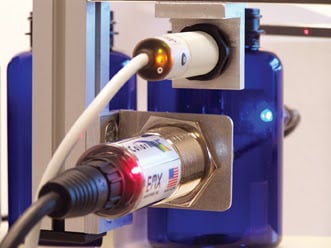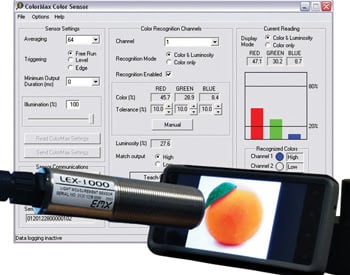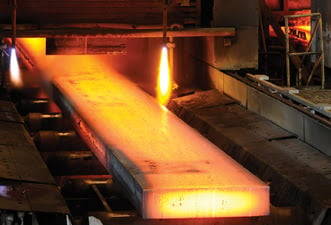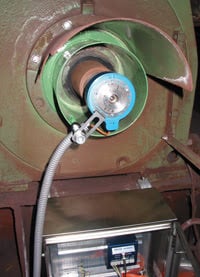
Optical Sensors Speed Up Production Lines
Recent advances in optical sensors enable the industry to monitor manufacturing processes on line in real time at a very fast rate.
Optical sensors are not only essential for safety on the production line, but they are also fast becoming an indispensable tool for manufacturers to save power, time and money, thanks to the speedy and precise measurements they provide.
Photonics has given industrial manufacturing a precision factor that previously was impossible to implement. Today, manufacturers can execute several technologies that allow for noncontact control, measuring and monitoring of manufacturing processes very cost-effectively.
“For example, during manufacturing of films, it is important to measure their color and opacity; color and opacity sensors do that reliably, fast and around the clock,” said Joe Rozgonyi, president of EMX Industries Inc. in Cleveland, an innovator of specialty sensors for use in automotive, packaging, metal stamping and pharmaceutical manufacturing, to name a few.

Optical sensors are fast becoming indispensable in manufacturing for the power, time and cost savings they offer. Here, a color sensor verifies the color of a plastic bottle in a manufacturing setting. Courtesy of EMX Industries Inc.
“Light-based sensors are extremely important in automating manufacturing processes. These sensors are fast and accurate in measuring optical characteristics – that is impossible to achieve any other way, effectively or economically,” he added.
With safety a top priority in most factories, perhaps the most prominent use for light-based sensors is as infrared light curtains. Light barriers, as they also are sometimes known, are devices that detect the presence of personnel in the vicinity of potentially dangerous moving machinery.
Comprising a transmitter and receiver pair, the light curtain transmitter projects an array of parallel infrared light beams to the receiver, which consists of a number of photoelectric cells. When an object breaks one or more of the beams, a stop signal is sent to the equipment.

This light-analysis sensor is analyzing the RGB values of a display for an industrial application. Courtesy of EMX Industries Inc.
Other applications of optical sensors include intelligent lighting, infrared touch switches, proximity sensors for object/distance/presence detection and transmissive sensors in motor applications.
The wavelength of light used by the sensor depends on the application, but typically ranges from infrared to ultraviolet; e.g., diffuse sensors, which are used to sense contrast, work by projecting a visible light beam onto a target, then analyzing the gray scale of the reflected light.
In color sensors, highly stable white light works best for optimal color recognition. For example, for color detection of transparent materials, a through-beam configuration is used, whereby the light source is placed on one side, the transparent material placed in the middle and the receiver analyzing the color positioned on the other side. Finally, luminescence sensors usually are composed of ultraviolet light sources in the 350-nm range, with receivers in the visible wavelength range.
Challenges and advances
A factory setting poses a unique set of challenges for optical sensors manufacturers such as Vishay Intertechnology Inc. of Malvern, Pa. At the top of the list is developing components that can withstand the barrage of particulates commonly generated within a manufacturing plant.
“Dirty environments [are] still a challenge for optical sensors,” said Mohan Kumar Kannusamy, product marketing manager of sensors at Vishay Intertechnology. “But [this] can be overcome by using calibration measurements and high-resolution sensors.”
Another challenge for sensors is withstanding extreme temperatures, which the company has helped to address with two of its newest: the TCUT1350X01 and TCPT1350X01 sensors, which can operate at 125 °C. “No other transmissive or slotted interrupter can do this,” Kannusamy said.

Optical sensors are vital in steel mills, where steel is melted and processed into slabs or plates on continuously operating machinery at elevated temperatures.
Avago Technologies’ latest generation of sensors has three primary trends: more programmable features with I2C (interintegrated circuits) communications; additional LED current and gain selections for optimal proximity detection; and availability of proximity offset register to compensate for proximity offsets caused by device variations, optical crosstalk and other environmental factors.
“We are excited about a new proximity sensor, APDS-9130, and integrated sensor, APDS-9930, which are being launched now,” said Hui Ling Neo, product manager for Avago’s optical sensor products. “These devices are the latest updates to the product family, featuring low Vcc [voltage from power supply connected to the ‘collector’ terminal] operation down to 2.2 V and improved ALS [ambient light sensor] and PS [proximity sensor] dynamic range.”
At EMX Industries Inc., one of the exciting new developments is the application of opacity sensors in the manufacture of pharmaceutical packaging. “The control and verification of light barrier in pharmaceutical packaging is critical, and it is part of any FDA medication approval process,” Rozgonyi said. “Until recently, the only option to monitor the opacity was to rely on statistical sampling.” EMX Industries’ Opax sensor monitors each package for opacity – that’s 100 percent testing, compared to a statistical batch control. This innovation prevents product waste and, in the worst case, potentially unsafe medication being dispensed.
Technology bottleneck
In the future, there will of course be miniaturization, integration and standardization, as these continue to drive optical sensor technology. But, according to Rozgonyi, a bottleneck exists that makes it difficult to advance optical sensor technology any further.
“The progress in light sources technologies has increased the performance range and accuracy of light-based sensors at ever-decreasing costs per unit,” he said. “Optical components and light receivers lag in their development behind light sources, and further development is needed to take the light-based sensors to the next level.”
Fiber optic sensors
Optical fibers can be used to measure strain, temperature and pressure, and certain industries have long taken advantage of this. For example, fiber optic sensors have been sent down oil wells; they are used as chemical sensors measuring pH content for gas analysis and spectroscopic studies; and they are used as biomedical sensors (inserted via catheters or endoscopes to measure blood flow, glucose content and so on).
Fiber optic data transmission has certainly reached mainstream use in the telecommunications, medical and military/aerospace markets. Although fiber optic networking has been expanding in the industrial market, the growth ramp has been slower for fiber optic sensors in industrial applications. Perhaps this is due largely to optical sensor systems being more expensive than conventional electronics-based sensors.
On the plus side, passive fiber optic sensors offer several benefits over conventional electronics-based sensors, including immunity to electromagnetic and radio-frequency interference as well as lightning and ground loops. They are inherently safe for use in explosive environments such as mines, petrochemical plants, oil rigs and grain elevators, and they can operate over wide temperature ranges.
Also, since optical fiber sensors are passive, they do not require power and offer the longest-distance sensor links (up to 2500 m, in some cases).
Micronor Inc. of Newbury, Calif., has long served the industrial automation market with mechanical motion-sensing products. In 2003, it opened a new facility in Newbury Park to design and manufacture innovative fiber optic sensor systems, including fiber optic rotary and linear encoders (position sensors) and fiber optic temperature sensors.

A fiber optic encoder keeps watch in a steel rolling mill in Germany. Courtesy of Micronor Inc.
Although fiber optic sensors may not be the first option that many manufacturers consider, they are often the only solution in challenging environments, suggests Dennis Horwitz, vice president of sales and marketing at Micronor.
“Due to their higher cost, fiber optic sensors tend to be used in challenging environments where conventional electronics-based sensors don’t perform well or not at all – mines, oil rigs, robotic welders, steel mills, electric trains and MRI are sample applications,” he said. “For example, mining represents a harsh, hazardous, dirty and grimy environment, where control equipment on the outside must reach long distances underground as well as aboveground.”
Conveyor systems for moving the ore can stretch incredibly long distances, reaching hundreds of meters or even many kilometers. The control systems require encoders for closed-loop feedback to ensure optimal system operation. Remote high-voltage VFD (variable-frequency drive) motors drive power and control the powerful motors along the conveyor route.
Steel-rolling mills are another manufacturing example at which fiber optic encoders excel for other reasons.
“Taking molten steel and processing it into slabs and plates requires continuous operation at elevated temperatures together with the physical pounding and mechanical stress of the rolling process,” Horwitz said. “Conventional encoders fail frequently in this type of application. The cost of repairs and unscheduled down time [are] important considerations in this and other similar manufacturing and process applications.”
Fiber optic sensors are used to gauge position, commutation, rotary motion (wheel speed, direction and angular position) and temperature. Since most fiber optic sensors are not transducers (devices that convert one form of energy into another), they require a remote interrogator – typically a module or instrument box containing the optoelectronic interface for the sensor and the electrical interface, which connect to the industrial control equipment. The fiber optic link then connects the sensor and its interrogator.
The nature of the cable means that information can be passed in opposite directions without causing interference, making it possible to send the interrogation light beam to the sensor and receive the modulated signal back over the same optical fiber.
Ongoing challenges for fiber optic sensors include being tolerant to nonconforming fiber links. This means that changes in optical link quality must not affect sensor measurement, making high-performance connectors and cabling an essential part of the system. And while high cost is a disadvantage, this can be mitigated with increased volume. But, above all, fiber optic training for all personnel is an essential investment.
“Companies must invest in training so that the technology is applied and handled properly,” Horwitz said. “Too many companies have tried to treat fiber optics like copper and have failed miserably.”
Published: September 2013